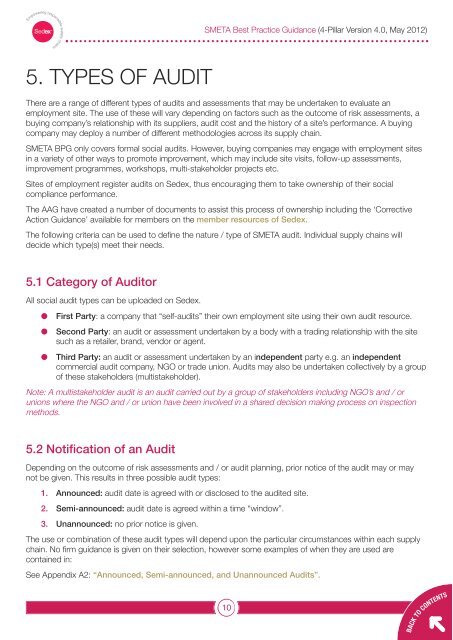Sedex Members Ethical Trade Audit (SMETA) Best Practice Guidance
Sedex Members Ethical Trade Audit (SMETA) Best Practice Guidance
Sedex Members Ethical Trade Audit (SMETA) Best Practice Guidance
You also want an ePaper? Increase the reach of your titles
YUMPU automatically turns print PDFs into web optimized ePapers that Google loves.
5. TYPES OF AUDIT<br />
There are a range of different types of audits and assessments that may be undertaken to evaluate an<br />
employment site. The use of these will vary depending on factors such as the outcome of risk assessments, a<br />
buying company’s relationship with its suppliers, audit cost and the history of a site’s performance. A buying<br />
company may deploy a number of different methodologies across its supply chain.<br />
<strong>SMETA</strong> BPG only covers formal social audits. However, buying companies may engage with employment sites<br />
in a variety of other ways to promote improvement, which may include site visits, follow-up assessments,<br />
improvement programmes, workshops, multi-stakeholder projects etc.<br />
Sites of employment register audits on <strong>Sedex</strong>, thus encouraging them to take ownership of their social<br />
compliance performance.<br />
The AAG have created a number of documents to assist this process of ownership including the ‘Corrective<br />
Action <strong>Guidance</strong>’ available for members on the member resources of <strong>Sedex</strong>.<br />
The following criteria can be used to define the nature / type of <strong>SMETA</strong> audit. Individual supply chains will<br />
decide which type(s) meet their needs.<br />
5.1 Category of <strong>Audit</strong>or<br />
All social audit types can be uploaded on <strong>Sedex</strong>.<br />
l First Party: a company that “self-audits” their own employment site using their own audit resource.<br />
l Second Party: an audit or assessment undertaken by a body with a trading relationship with the site<br />
such as a retailer, brand, vendor or agent.<br />
l Third Party: an audit or assessment undertaken by an independent party e.g. an independent<br />
commercial audit company, NGO or trade union. <strong>Audit</strong>s may also be undertaken collectively by a group<br />
of these stakeholders (multistakeholder).<br />
Note: A multistakeholder audit is an audit carried out by a group of stakeholders including NGO’s and / or<br />
unions where the NGO and / or union have been involved in a shared decision making process on inspection<br />
methods.<br />
5.2 Notification of an <strong>Audit</strong><br />
Depending on the outcome of risk assessments and / or audit planning, prior notice of the audit may or may<br />
not be given. This results in three possible audit types:<br />
1. Announced: audit date is agreed with or disclosed to the audited site.<br />
2. Semi-announced: audit date is agreed within a time “window”.<br />
3. Unannounced: no prior notice is given.<br />
<strong>SMETA</strong> <strong>Best</strong> <strong>Practice</strong> <strong>Guidance</strong> (4-Pillar Version 4.0, May 2012)<br />
The use or combination of these audit types will depend upon the particular circumstances within each supply<br />
chain. No firm guidance is given on their selection, however some examples of when they are used are<br />
contained in:<br />
See Appendix A2: “Announced, Semi-announced, and Unannounced <strong>Audit</strong>s”.<br />
10<br />
BACK TO CONTENTS


